A fun and recreational activity that also serves to work all the muscles of the body at the same time.
At the stage when many prefer to sit rather than move, training and fitness lifestyle could be the keys to maintain quality of life. As we age, the body loses muscle mass, the risk of falls, fractures, loss of autonomy and capacity increases.
The content you want to access is exclusive to subscribers.
Therefore, incorporating stimulating and effective activities is more than an option: it is a necessity for age healthily. It’s not about heavy gym routines, nor necessarily lifting weights every day. The objective is to find an attractive, accessible practice that invites you to move with pleasure and perseverance.


Fun training

Ballroom dancing is a good exercise option for older adults.
freepik
Ballroom dancing: the recommended training to recover muscle mass
When we talk about exercises for older adults, we often think of walking, stretching, or gym machines. However, ballroom dancing (and in particular the waltz) appears as a ideal alternative for several reasons. This type of low-impact dance helps tone muscles, improve balance, coordination and physical endurance in older people.
Among its many benefits, we can highlight:
- Stimulates several complete muscle groups: By moving in coordinated steps, activating legs, trunk, arms and maintaining posture, the body is worked in a comprehensive manner.
- Improves balance and prevents falls: Control when moving and changing direction smoothly strengthens the stability of the body, a critical factor in advanced ages.
- Stimulates cardiovascular and respiratory resistance: Dancing raises the heart rate moderately, which is positive for the health of the heart and pulmonary system.
- Accessible and low impact: does not require jumps or sudden movements; It can be adapted to each person’s level, reducing the risk of injury.
But also, it is a training accessible to everyone:
- Fun and motivating: By having rhythmic differences, music, social accompaniment, it becomes a practice that engages more than many “traditional” routines.
- Easy to adapt– Steps can be simplified or adjusted to the physical limitations of the practitioner (shorter movements, less turning, etc.).
- Social and psychological component: Attending dance classes involves interacting, connecting with others, which is beneficial for mood, memory and general motivation.
- Specific prevention of sarcopenia: By applying moderate effort and constant movement, it helps reverse or mitigate the loss of muscle mass associated with age.
Source: Ambito
I am an author and journalist who has worked in the entertainment industry for over a decade. I currently work as a news editor at a major news website, and my focus is on covering the latest trends in entertainment. I also write occasional pieces for other outlets, and have authored two books about the entertainment industry.




